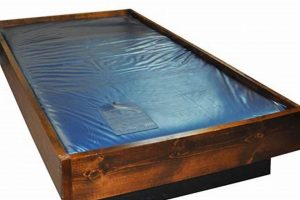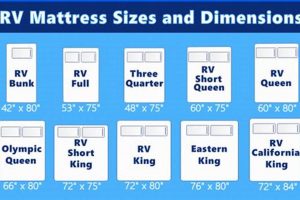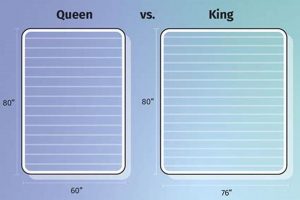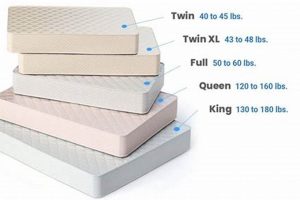The largest standard residential bedding option, excluding specialty sizes, is designed to provide ample space for individuals or couples. Typically measuring 72 inches wide and 84 inches long, this sleeping surface offers extra length compared to its wider counterpart, catering particularly to taller individuals. A complete offering usually incorporates the sleep surface, and its matching foundation.
The generous dimensions are conducive to undisturbed rest, mitigating the likelihood of partners disrupting each other’s sleep. The added length prevents discomfort for those exceeding average height, eliminating the need to sleep diagonally. Historically, larger beds have signified luxury and comfort, a trend continuing in modern preferences for increased personal space during sleep.
Subsequent sections will delve into the various materials used in their construction, optimal frame selection, and considerations for choosing the appropriate linens and bedding to complement its size and enhance the overall sleep experience. Detailed analysis of available features and technological advancements will also be presented.
Selection and Maintenance Guidance
The subsequent recommendations are intended to facilitate informed decisions regarding the acquisition and upkeep of a specific large-format bedding solution.
Tip 1: Assess Room Dimensions: Prior to purchase, measure the bedroom space to ensure adequate clearance around the bed. Consider door swing, walkway space, and the placement of other furniture.
Tip 2: Evaluate Foundation Compatibility: Verify that the existing or intended bed frame is appropriately sized and structurally sound to support the dimensions and weight of a complete unit. Inadequate support may compromise the lifespan of the sleep surface.
Tip 3: Research Material Composition: Investigate the internal components, including foam density, coil type, and ticking material. Consider individual preferences for firmness, support, and temperature regulation.
Tip 4: Consider Motion Isolation: For shared sleep environments, evaluate motion isolation properties. Individual pocketed coils or layered foam construction can minimize the transmission of movement.
Tip 5: Utilize Protective Bedding: Employ a mattress protector to guard against spills, stains, and allergens. This practice extends the lifespan of the sleep surface and maintains warranty validity.
Tip 6: Implement Regular Rotation: Rotate the mattress every three to six months to promote even wear and prevent body impressions. Some models may also benefit from flipping, if applicable.
Tip 7: Adhere to Cleaning Protocols: Follow manufacturer guidelines for cleaning spills and stains. Avoid harsh chemicals and excessive moisture, which can damage internal components.
Adherence to these guidelines will contribute to an extended lifespan, enhanced comfort, and maintained hygienic conditions. Informed decisions made prior to acquisition are crucial for optimizing long-term satisfaction.
The final section will present a comparative analysis of available brands and models, focusing on key features, warranty provisions, and consumer feedback.
1. Dimensions
The physical size is a defining characteristic, influencing bedroom compatibility, sleep comfort, and overall user satisfaction. Precise understanding of these measurements is crucial for informed decision-making.
- Width and Length Specifications
The standard dimensions measure 72 inches in width and 84 inches in length. This configuration provides additional length compared to its wider counterpart, accommodating taller individuals who require extra legroom. Failure to account for these specific measurements during bedroom planning can result in an unsuitable fit and diminished functionality.
- Thickness Considerations
The height, ranging from approximately 8 to 18 inches, affects accessibility and aesthetics. Thicker profiles can provide enhanced comfort layers, but necessitate higher bed frames, potentially creating challenges for individuals with mobility limitations. Conversely, thinner profiles may not offer sufficient support for certain body types or sleep preferences.
- Weight Implications
Due to the increased surface area, it exhibits a greater overall mass compared to smaller sizes. This weight impacts ease of handling, transportation, and bed frame selection. Bed frames must possess adequate structural integrity to support the combined weight of the product and its occupants to prevent damage or structural failure.
- Impact on Bedding Selection
The unique dimensions necessitate specialized linens. Standard king-size sheets will not adequately fit, requiring specifically tailored or oversized bedding to ensure complete coverage and aesthetic appeal. Failure to use appropriately sized bedding can result in discomfort, reduced thermal regulation, and an unkempt appearance.
A comprehensive understanding of these dimensional facets is essential for optimizing the utilization. Neglecting these considerations can lead to compromised sleep quality, practical challenges, and diminished long-term satisfaction.
2. Support System
The internal structure is fundamental to its overall performance. This subsystem dictates the level of postural support, spinal alignment, and motion isolation provided to the user. A comprehensive understanding of these components is essential for selecting a product that meets individual needs and preferences.
- Coil Systems
Coil systems, traditionally innerspring units, provide a resilient and supportive base. The gauge and configuration of the coils influence firmness and responsiveness. Continuous coil designs offer affordability and durability, while pocketed coils minimize motion transfer by isolating individual movements. The choice of coil system directly impacts the suitability for specific sleep positions and body weights. For instance, heavier individuals may benefit from a higher coil count and thicker gauge for enhanced support.
- Foam Core Constructions
Foam core systems, often utilizing memory foam or latex, offer contouring support and pressure relief. Memory foam conforms to the body’s shape, distributing weight evenly and reducing stress on pressure points. Latex provides a more responsive feel with natural resilience. The density and layering of foam impact firmness and temperature regulation. Higher density foams offer increased durability and support but can retain more heat. Hybrid models combine foam layers with coil systems to leverage the benefits of both technologies.
- Zoning and Edge Support
Zoning involves varying the firmness across different
sections to provide targeted support to specific areas of the body. Lumbar support, for example, can enhance spinal alignment and reduce back pain. Edge support reinforces the perimeter, preventing sagging and maximizing the usable sleep surface. These features are particularly relevant for its size as individuals often utilize the full width. Adequate edge support facilitates ease of getting in and out of bed and prevents the sensation of rolling off the edge. - Adjustable Bases
Integration with an adjustable base transforms the functionality. These bases allow users to elevate the head and foot, promoting circulation, reducing snoring, and enhancing comfort for activities such as reading or watching television. Adjustable bases can be paired with compatible models to create a customizable sleep system that caters to individual comfort preferences and medical needs. This is especially relevant when paired, allowing for individual customization.
The interplay between these various support system facets determines the overall comfort, durability, and suitability of a large sleep surface. Careful consideration of individual preferences and requirements is paramount in selecting a product that delivers optimal sleep quality and long-term satisfaction.
3. Material Composition
Material composition directly dictates several critical performance characteristics. The constituent components, ranging from internal support structures to external ticking fabrics, influence durability, comfort, thermal regulation, and allergenicity. For example, a coil system constructed from high-gauge steel provides enhanced support and longevity compared to low-gauge alternatives, resulting in a firmer and more resilient sleeping surface. Similarly, the density and type of foam used in comfort layers significantly affect pressure relief and motion isolation, with memory foam conforming to the body’s contours and minimizing the transmission of movement. The choice of ticking fabric impacts breathability and moisture wicking, thereby affecting sleep temperature. Natural fibers, like cotton or bamboo, generally offer superior breathability compared to synthetic materials. Furthermore, the presence of flame retardants and other chemical treatments can influence potential off-gassing and allergenicity, prompting consideration of certifications like OEKO-TEX or CertiPUR-US.
Understanding the implications of material composition enables informed decision-making. Individuals with allergies or sensitivities may prioritize hypoallergenic materials such as latex or organic cotton to minimize potential irritation. Those experiencing back pain might seek out models with targeted lumbar support zones and pressure-relieving memory foam. Individuals residing in warmer climates may opt for breathable ticking fabrics and gel-infused memory foam to mitigate heat retention. Retailers often provide detailed specifications regarding the materials used in a particular model, allowing consumers to assess their suitability based on individual needs and preferences. Failure to consider material composition can lead to discomfort, allergic reactions, or premature product degradation, ultimately compromising the sleep experience.
In summary, material composition is an integral aspect. Its impact on performance, durability, and user health necessitates careful evaluation during the selection process. Prioritizing transparent material sourcing, understanding the characteristics of different component types, and aligning material choices with individual needs are essential for ensuring long-term satisfaction.
4. Foundation Compatibility
The selection of an appropriate foundation is a crucial determinant of the lifespan, comfort, and warranty validity of a large bedding item. A mismatch between a bedding unit and its underlying support system can lead to premature wear, compromised structural integrity, and voided manufacturer guarantees. The subsequent discussion explores key considerations regarding ensuring proper support.
- Structural Integrity and Weight Capacity
The foundation must possess adequate structural integrity to support the dimensions and weight of a sleep surface and its occupants. Exceeding the weight capacity can result in sagging, warping, or even complete failure of the support structure. For example, a lightweight metal frame may be insufficient to adequately support a heavy latex mattress and two adults, leading to uneven wear and potential damage to both components.
- Dimensional Accuracy and Fit
Precise dimensional matching between the bedding unit and foundation is essential for optimal performance. Overhang or gaps can create instability and discomfort, while an undersized foundation provides inadequate support. A platform base with dimensions slightly smaller than the corresponding bedding unit can result in sagging edges and reduced usable sleep surface. Conversely, a foundation that is too large can cause the bedding to shift and slide, compromising sleep quality.
- Foundation Type and Material Compatibility
Different foundation types exhibit varying degrees of compatibility with different mattress materials. Box springs, traditionally used with innerspring mattresses, may not provide adequate support for foam or hybrid models. Platform bases, consisting of solid or slatted surfaces, generally offer greater versatility and are suitable for a wider range of mattress types. Adjusting the slat spacing can tailor the support level of platform bases. Incorrect combinations may reduce support.
- Warranty Compliance and Manufacturer Recommendations
Many bedding manufacturers stipulate specific foundation requirements in their warranty terms. Failure to adhere to these recommendations can void the warranty in the event of premature wear or structural failure. For example, some warranties mandate the use of a matching foundation from the same manufacturer, while others specify minimum slat spacing requirements for platform bases. Consult the warranty documentation and manufacturer guidelines prior to purchasing to ensure compliance and maintain coverage.
The synergistic relationship between bedding unit and foundation significantly influences the overall sleep experience and product longevity. A deliberate selection process that considers structural integrity, dimensional accuracy, material compatibility, and warranty compliance is essential for maximizing value and ensuring long-term satisfaction. Neglecting these factors can lead to compromised sleep quality, reduced product lifespan, and voided manufacturer guarantees.
5. Temperature Regulation
Effective temperature regulation is a critical aspect of a quality sleeping experience, particularly relevant in the context of large-format bedding. The expansive surface area can exacerbate issues related to heat retention, underscoring the importance of materials and construction techniques designed to promote airflow and dissipate body heat.
- Material Breathability and Airflow
The constituent materials significantly influence breathability. Nat
ural fibers, such as cotton, wool, and bamboo, generally exhibit superior airflow compared to synthetic alternatives like polyester or polyurethane foam. Open-cell foam structures, as opposed to closed-cell configurations, facilitate greater air circulation and heat dissipation. The selection of breathable materials is essential for minimizing heat build-up and maintaining a comfortable sleeping temperature. - Cooling Technologies and Infusions
Various cooling technologies aim to mitigate heat retention. Gel-infused memory foam incorporates gel particles to absorb and dissipate body heat. Phase change materials (PCMs) absorb or release heat as needed to maintain a consistent temperature. These technologies can enhance thermal regulation, particularly for individuals prone to overheating during sleep. However, the effectiveness of these technologies varies depending on factors such as ambient temperature and humidity.
- Mattress Construction and Ventilation
The internal architecture impacts airflow. Hybrid models, combining coil systems with foam layers, often exhibit better ventilation than all-foam designs. Perimeter ventilation systems, incorporating mesh or breathable fabrics along the edges, promote airflow and prevent heat from trapping. Internal channels or cutouts within foam layers can also enhance ventilation. A construction approach that prioritizes airflow is crucial for minimizing heat accumulation and maintaining a comfortable sleep environment.
- Bedding and Linens
The choice of bedding materials influences thermal regulation. Lightweight, breathable sheets made from natural fibers, such as cotton or linen, promote airflow and prevent overheating. Heavier, synthetic blankets can trap heat and exacerbate temperature regulation issues. The use of moisture-wicking mattress protectors can help to draw moisture away from the body, further enhancing thermal comfort. Selecting appropriate bedding materials is an integral component of managing sleep temperature.
The interplay between material selection, cooling technologies, mattress construction, and bedding choices determines the efficacy. A comprehensive approach that addresses all facets of thermal regulation is crucial for maximizing comfort. Failure to prioritize temperature management can result in disrupted sleep and diminished overall well-being. Consideration of these factors is essential for optimizing the sleep environment.
6. Longevity
The extended lifespan represents a significant factor in the overall value proposition. Durability ensures a prolonged return on investment, reducing the frequency of replacement and associated costs. Factors influencing degradation warrant careful consideration. The quality of materials and construction methods directly correlate with its resilience to wear and tear.
- Material Degradation Resistance
The inherent resistance of constituent materials to degradation under normal use conditions is paramount. High-density foams, tempered steel coils, and durable ticking fabrics contribute to a prolonged lifespan. Conversely, low-quality materials are susceptible to compression, sagging, and tearing, leading to premature failure. The selection of materials with documented resistance to degradation ensures sustained support and comfort over an extended period.
- Construction Integrity and Workmanship
Robust construction techniques and meticulous workmanship are essential for maintaining structural integrity. Reinforced seams, durable binding, and secure component assembly prevent premature wear and tear. Inferior construction methods, such as weak stitching or inadequate adhesive application, can compromise structural stability. Careful examination of construction details provides insights into the overall durability and expected lifespan.
- Proper Usage and Maintenance
Adherence to recommended usage and maintenance practices significantly impacts lifespan. Regular rotation prevents uneven wear and prolongs the lifespan. Protective measures, such as mattress protectors, safeguard against spills, stains, and allergens. Failure to follow these guidelines can accelerate deterioration and shorten the lifespan.
- Warranty Provisions and Coverage
The manufacturer’s warranty provides insights into the expected lifespan and potential defects. Comprehensive warranties covering sagging, structural defects, and material failures offer assurance of product quality and longevity. Reviewing warranty provisions allows consumers to assess the manufacturer’s confidence and understand the scope of coverage.
These facets interconnect, highlighting how material choices, construction integrity, user behavior, and warranty provisions collectively influence the longevity. A judicious purchase decision considers these aspects to optimize lifespan and ensure a satisfactory long-term investment.
Frequently Asked Questions
This section addresses common inquiries regarding the dimensions and utilization.
Question 1: What are the precise measurements?
It typically measures 72 inches in width and 84 inches in length. These dimensions are intended to provide additional length compared to standard king-size models.
Question 2: Does standard king-size bedding fit?
Standard king-size bedding is generally not suitable. The unique dimensions necessitate specialized or oversized sheets to ensure adequate coverage.
Question 3: What type of frame is required?
A frame specifically designed to accommodate its dimensions and weight is essential. Ensure adequate support to prevent sagging and maintain warranty validity.
Question 4: Is it suitable for individuals with back pain?
Suitability depends on individual preferences and support requirements. Models offering zoned support or adjustable firmness levels may provide enhanced comfort for individuals with back pain.
Question 5: How often should the unit be rotated?
Rotation every three to six months is recommended to promote even wear and prevent body impressions. Some models may also benefit from flipping, if applicable.
Question 6: What is the typical lifespan?
The lifespan varies depending on material quality, construction, and usage patterns. However, with proper care and maintenance, a high-quality set can last for several years.
Understanding these frequently asked questions can aid decision-making.
The following article will explore brands and models available.
Conclusion
This article has provided a comprehensive overview of the california king mattress set, encompassing its dimensions, support systems, material composition, foundation compatibility, temperature regulation capabilities, and expected longevity. Each of these attributes contributes significantly to the overall user experience and long-term value proposition. Careful consideration of these factors is essential for informed decision-making.
The appropriate selection of a california king mattress set represents a substantial investment in sleep quality and well-being. Further research into specific brands, models, and consumer reviews is strongly encouraged to ensure a purchase that aligns with individual needs and preferences. Long-term sleep quality depends on careful due diligence.



![Best Walmart King Size Blow Up Mattress [Deals!] Organic & Natural Mattress Buyer’s Guide: Non-Toxic Sleep Solutions Best Walmart King Size Blow Up Mattress [Deals!] | Organic & Natural Mattress Buyer’s Guide: Non-Toxic Sleep Solutions](https://mattressworldpa.com/wp-content/uploads/2025/07/th-8177-300x200.jpg)


![Best Soft King Mattress [Guide] For Restful Sleep Organic & Natural Mattress Buyer’s Guide: Non-Toxic Sleep Solutions Best Soft King Mattress [Guide] For Restful Sleep | Organic & Natural Mattress Buyer’s Guide: Non-Toxic Sleep Solutions](https://mattressworldpa.com/wp-content/uploads/2025/07/th-8174-300x200.jpg)
